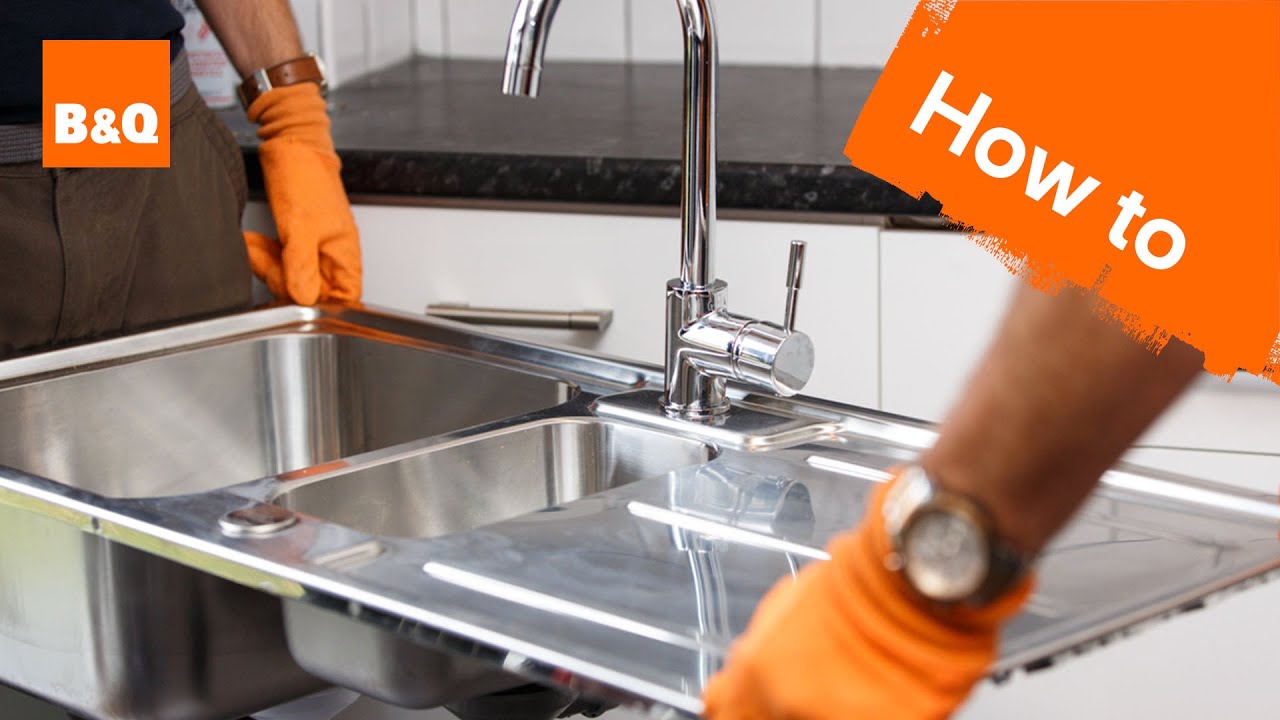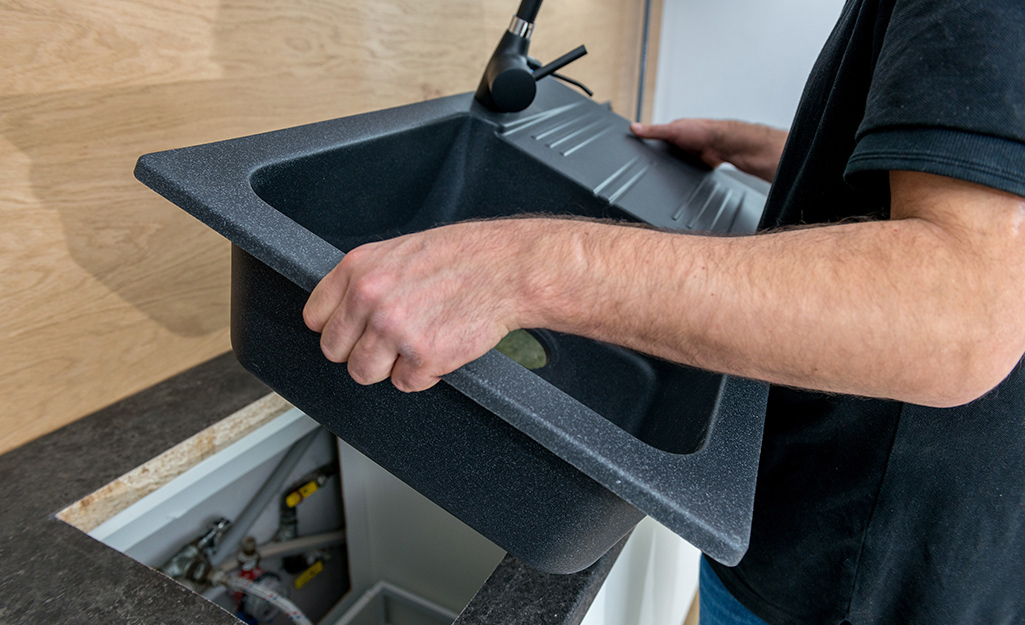Replacing a kitchen sink can seem like a daunting task. However, with the right steps and tools, it can be done easily and efficiently.
A kitchen sink is an essential part of any home. It experiences daily use, so over time, wear and tear can occur. You might notice leaks, rust, or simply want a new style. Replacing your sink not only improves function but can also enhance your kitchen’s appearance.
This project can save you money and bring a fresh look to your space. Whether you are a DIY enthusiast or just starting, this guide will help you understand the process. Get ready to transform your kitchen with a new sink!

Credit: www.youtube.com
Preparation For Sink Replacement
Replacing a kitchen sink requires careful preparation. Gather necessary tools and materials first. Turn off the water supply to prevent leaks. Clear the area under the sink for easy access, and ensure you have a replacement sink ready. Following these steps will make the process smoother.
Replacing a kitchen sink can be a rewarding DIY project that revitalizes your space. However, preparation is key to ensuring a smooth and successful replacement process. This stage sets the foundation for your project, making the actual replacement easier and more efficient. Let’s dive into what you need to do before you get started.Gathering Tools And Materials
Start by gathering all the necessary tools and materials. You’ll need: – A new sink – Adjustable wrench – Screwdriver set – Plumber’s putty – Silicone caulk – Basin wrench – Towels or sponge Having everything ready at hand minimizes interruptions during the installation. I remember the first time I replaced my sink; I had to make multiple trips to the hardware store. It was frustrating and time-consuming. Double-check that your new sink matches your kitchen’s plumbing and layout. If you’re unsure, bring the old sink with you for comparison. This small step can save you from potential headaches later on.Measuring The Sink Area
Accurate measurements are crucial for a successful sink replacement. Begin by measuring the length, width, and depth of your current sink. – Length: Measure from one side of the sink to the other. – Width: Measure from the front to the back. – Depth: Measure how deep the sink is from the top rim to the bottom. Don’t forget to measure the cutout in your countertop. Ensure your new sink will fit comfortably in that space. It’s wise to have a little wiggle room; a snug fit can lead to installation issues. Consider the height of your faucet and any extra features, like a soap dispenser or sprayer. You want to make sure everything aligns well. If you’ve ever installed a sink that was just a bit too large, you understand the importance of precision. Are you ready to tackle this project? Being thoroughly prepared will make the process much more enjoyable and less stressful.Turning Off Water Supply
Replacing a kitchen sink starts with turning off the water supply. This step prevents flooding and water damage. It is crucial to ensure a smooth replacement process. Follow these simple steps to shut off the water safely.
Locating The Shutoff Valves
First, find the shutoff valves under your sink. These valves control the water flow to your faucet. Usually, they are located on the wall or under the cabinet. Look for two small handles, one for hot and one for cold water.
Turn each valve clockwise to close them. You should feel resistance when they are fully closed. If the valves are hard to turn, use a wrench for better grip. Make sure both valves are shut off completely.
Draining Remaining Water
After shutting off the valves, it’s time to drain any remaining water. Open the faucet to allow water to flow out. This step removes pressure from the pipes.
Next, place a bucket under the sink. Disconnect the water supply lines carefully. Any leftover water will drain into the bucket. Once the water stops flowing, you are ready to proceed with your sink replacement.
Disconnecting Plumbing
Disconnecting the plumbing is a crucial step in replacing your kitchen sink. Properly detaching the water supply and drain pipes ensures a smooth replacement process. Follow these steps carefully to avoid leaks and damage.
Detaching Water Supply Lines
Start by turning off the water supply. Locate the valves under the sink. Turn them clockwise to shut off the water. Use an adjustable wrench to loosen the nuts on the water supply lines. Be careful not to damage the pipes.
Once loose, gently pull the lines away from the faucet. Have a towel ready to catch any water that may spill. Ensure the lines are completely detached before moving on.
Removing The Drain Pipe
Next, focus on the drain pipe. Look for the slip nuts that connect it to the sink and the trap. Use your hands or a wrench to unscrew these nuts. Be cautious, as some water may remain in the pipes.
Once the nuts are removed, gently pull the drain pipe away. Check for any old putty or debris that may need cleaning. Make sure the area is clear before installing your new sink.

Credit: www.homedepot.com
Removing The Old Sink
Removing the old sink can seem daunting. With the right steps, it becomes manageable. Follow these instructions to make the process smooth and easy.
Loosening The Mounting Hardware
Start by locating the mounting hardware. This is usually under the sink. Use a wrench to loosen the nuts. Turn counterclockwise to remove them. Check for any clips or brackets. Remove these with pliers if necessary. Keep all the hardware in a safe place.
Make sure to disconnect the sink from the countertop. This may involve cutting through any old caulk. A utility knife works well for this task. Carefully run the knife along the edges.
Lifting Out The Old Sink
Once the hardware is loose, it’s time to lift out the sink. Grab the sink from the edges. It may be heavy, so be cautious. If it feels stuck, check for any remaining connections. Ensure all pipes are disconnected.
With a firm grip, lift the sink straight up. If it’s an undermount sink, it may require extra effort. Tilt slightly to free it from the countertop. Place the old sink on a flat surface for disposal or recycling.
Preparing The Countertop
Preparing the countertop is an important step in replacing a kitchen sink. It ensures a secure fit for the new sink. Follow these steps to get ready.
Cleaning Old Adhesive Or Silicone
Start by removing the old sink. Carefully cut through any adhesive or silicone. Use a utility knife for this task. Take your time to avoid damaging the countertop.
Once you cut through, gently pull the old sink away. Use a scraper to remove leftover adhesive. Clean the surface thoroughly with a cloth. This prevents any residue from affecting the new sink.
Inspecting The Cutout For Adjustments
Next, check the sink cutout. Make sure it is the right size for the new sink. If it’s too small, you may need to enlarge it. Use a jigsaw for any adjustments.
Also, inspect the edges for rough spots. Smooth any rough areas with sandpaper. A clean, even cutout helps the new sink fit better.
Installing The New Sink
Installing a new kitchen sink can transform your cooking space. This process is straightforward. Follow these steps to ensure a successful installation.
Applying Sealant To The Edges
Start by applying a bead of sealant around the edge of the sink cutout. This creates a waterproof barrier. Use a caulking gun for an even application. Make sure the surface is clean and dry. Avoid using too much sealant. A thin line is often sufficient.
Positioning The Sink In Place
Carefully lower the sink into the cutout. Align it with the sealant line you applied. Press down gently to ensure a good seal. Check that the sink is level. Adjust as needed by adding or removing sealant. Secure the sink with clips or brackets as necessary. Ensure it is tight and stable before moving to the next step.
Reconnecting Plumbing
Reconnecting plumbing is a crucial step in replacing your kitchen sink. Proper connections ensure your new sink functions well. Follow these steps carefully to avoid leaks and other issues.
Reattaching Water Supply Lines
Start by locating the water supply lines. These are usually at the back of the sink. Make sure the valves are turned off. Use a wrench to connect the supply lines to the new faucet.
Ensure each connection is tight. Check for any damage to the washers. Replace them if necessary. Turn the water supply back on slowly. Watch for leaks as the water flows.
Connecting The Drain Pipe
Next, connect the drain pipe to your new sink. Align the drain with the existing pipe. Use the slip joint nut to secure the connection. Tighten it by hand, but do not overtighten.
Check the trap and ensure it fits properly. This part collects any leftover water. Finally, run water through the sink. Look for any leaks around the connections.
Testing The Installation
After installing the new kitchen sink, it’s essential to test the installation. Check for leaks by turning on the water and observing all connections. Ensure that the drain functions properly and that the faucet operates smoothly. This step guarantees a successful replacement and prevents future issues.
Testing the installation of your new kitchen sink is a crucial step that can save you from future headaches. After all the hard work you’ve put into replacing your sink, you want to ensure everything functions perfectly. A thorough testing process includes checking for leaks and ensuring proper water flow. Let’s dive into these essential checks.Checking For Leaks
After installing your new sink, the first thing to do is check for leaks. Turn on your water supply and observe all the connections. – Look at the faucet connections. – Inspect the drain assembly. – Pay attention to the water lines. Even a small leak can cause significant damage over time. If you notice any drips or wet spots, turn off the water and tighten the connections. You may also need to replace washers or seals.Ensuring Proper Water Flow
Once you’ve confirmed there are no leaks, it’s time to ensure that water flows smoothly from your new sink. Turn on the faucet and let the water run for a minute. – Is the water pressure strong? – Does it flow evenly from both hot and cold sides? If the water flow seems weak, check for blockages in the aerator or the water lines. A clogged aerator can hinder the flow, so clean it if necessary. Testing your installation not only gives you peace of mind but also confirms that your hard work has paid off. Have you ever faced unexpected issues during a DIY project?Final Touches
Replacing a kitchen sink can be a straightforward task. Start by turning off the water supply and disconnecting the old sink. Follow simple steps to install the new sink, ensuring a secure fit and proper connections for water lines and drainage.
Enjoy your upgraded kitchen space!
Replacing a kitchen sink can be a rewarding DIY project that enhances both the functionality and aesthetics of your kitchen. As you wrap up this task, the ‘Final Touches’ are essential for ensuring everything looks and works perfectly. These last steps may seem minor, but they make a significant impact on the overall outcome of your project. Let’s dive into the final touches that will have your sink shining and ready for use.Tightening All Fittings
Once you’ve connected your new sink, it’s time to tighten all the fittings. Use a wrench to secure the nuts and bolts connecting the sink to the countertop. Remember, you want these connections to be snug but not overtightened, which can cause damage. Take a moment to double-check every fitting, including the water supply lines and drain connections. Ensuring everything is tight now will save you from leaks and headaches later.Cleaning The Work Area
After securing all fittings, it’s time to clean up. Remove any debris, tools, or old materials from the countertop and surrounding areas. A clean workspace not only looks better but also helps you spot any potential issues with your new sink. Use a damp cloth to wipe down the sink and countertop, removing any fingerprints or smudges. Don’t forget to take a step back and admire your hard work. Your kitchen will feel refreshed, and you’ll be ready to enjoy your new sink! Have you thought about how often you’ll need to clean and maintain your new sink? Regular upkeep will ensure it stays in top shape for years to come.
Credit: housebythepreserve.com
Frequently Asked Questions
Can You Replace A Kitchen Sink Yourself?
Yes, you can replace a kitchen sink yourself. Ensure you have basic plumbing skills and tools. Follow proper steps to disconnect water lines, remove the old sink, and install the new one. If you encounter difficulties, consider hiring a professional.
Can You Replace A Kitchen Sink Without Replacing The Countertop?
Yes, you can replace a kitchen sink without changing the countertop. Ensure the new sink matches the existing cutout size. Minor adjustments may be possible, but significant changes may need countertop modifications. Properly disconnect plumbing and follow installation steps for a successful replacement.
Do You Need A Plumber To Replace A Sink?
Yes, you typically need a plumber to replace a sink, especially for complex installations. They ensure proper connections and prevent leaks. If you’re experienced with plumbing, you might handle it yourself, but hiring a professional is advisable for best results.
How Much Does A Plumber Charge To Replace A Kitchen Sink?
A plumber typically charges between $150 to $400 to replace a kitchen sink. Costs may vary based on location and complexity. Always request a quote before hiring to ensure transparency.
Conclusion
Replacing a kitchen sink may seem daunting. With the right tools and steps, it becomes manageable. Following this guide helps simplify the process. Always prioritize safety and double-check connections. A new sink can enhance your kitchen’s look and function. Take your time and don’t rush.
Enjoy your updated space once the job is done. Your kitchen will feel fresh and inviting. Happy DIYing!



